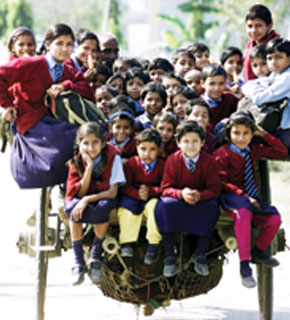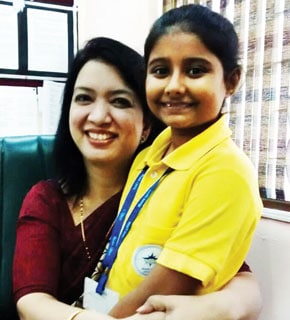
Private schools in India have managed to fill the void left by government measures in school education to a large extent. But how far can it go towards achieving the goals that education seeks to achieve in today’s knowledge economy? Elets News Network reads the fine print
 Attaining sustainable all round development, the central imperative in today’s globalised world, requires certain fundamental pillars in place. Education is one such pillar without which any future growth is inconceivable. To imagine growth with a large chunk of the country bounded in illiteracy is just impossible; more so in today’s information based society where education is the key to a whole world of opportunities. History has been witness to a whole host of issues in fields of healthcare, economic opportunity, women empowerment and community building that can be traced purely to lack of proper education. Despite a rich history of education in India, the country is still plagued with high levels of illiteracy and drop-outs. The scenario in many ways is scary.
Attaining sustainable all round development, the central imperative in today’s globalised world, requires certain fundamental pillars in place. Education is one such pillar without which any future growth is inconceivable. To imagine growth with a large chunk of the country bounded in illiteracy is just impossible; more so in today’s information based society where education is the key to a whole world of opportunities. History has been witness to a whole host of issues in fields of healthcare, economic opportunity, women empowerment and community building that can be traced purely to lack of proper education. Despite a rich history of education in India, the country is still plagued with high levels of illiteracy and drop-outs. The scenario in many ways is scary.
 Kavisha Khurana Vij
Kavisha Khurana VijDirector, The Chintels School
“Our text books are only teaching them what to think and not how to think. Let the education be such that prepares our children for tomorrow. Our children can’t change history (they can always learn from it) but they can make the future.”
The history of education as it stands today stems from the time when Lord Maculay proposed in the 20th century that Indians should attain modern education to come out of their traditional thoughts, interests, intelligence and morals. While that speech made by Macaulay has had different takes, perhaps it is time we focus on real challenges that face our system and state of primary education today. On its part, the government has initiated several schemes and programmes to improve the scenario and funds have also been allocated for the same. However, the impact of these measures is not one would expect.
That government schools have failed to address the rising demand for education would be to state the obvious. The state of government schools in India in terms of infrastructure, discipline, teachers and several other factors is miserable and there are no doubts about it. There are large gaps that have existed due to the government’s failure to address issues that have adversely affected the state of education in India in general. It is this gap (supplemented by a glaring disparity between the scale and quality required in education and the government’s ability to provide for it) that has led to the rise of private schools in big cities but also in small towns.
When it comes to the perceptions regarding private schools in India, it has traditionally been considered to be the exclusive premise of children who hail from rich families, have big money to spend and have had generations exposed to good education. However, the actual scenario is different from popular perception. Private schools today exist not just in cities but also in small towns and tier II, III and IV cities. In fact, had it not been for the emergence of private schools in the country, much of the population entering formal education would otherwise have remained uneducated.
 Carl Laurie
Carl LauriePrincipal, Christ Church School, Mumbai
“The generation we are dealing with are natives of the IT age. It’s here to stay and to grow. So we have to accept it; and yes, try and make best use of it. This is the knowledge age, and no one will deny that technology is the best tool to acquire, test, share and contribute to this knowledge bank.”
The contribution of private schools in improving the overall scenario is imminent and their share is only set to increase in coming years. Consider the following figures in this case. Number of government schools currently stands at 1.1 million with an enrolment of 153 million students. In contrast, the number of private schools stands at 3,39,000 with an enrolment of 100 million. To achieve the abovementioned figures, India will need an additional 130,000 private schools by 2022. The share of private schools enrolment is estimated to be 55-60 per cent in 2022 getting 500-550 students per new school. In rural India, 24 to 40 per cent of children are currently enrolled in private schools. In poor urban areas, the figure is at least 65 per cent.
The role that private schools in India need to play is amply clear from our Plan documents. What remains to be seen is the path we take to achieve it. There is a clear school of thought that argues that India’s mad rush to achieve high GER can be a risky proposition. And there is merit to this argument. Just like higher education is not just about the number of universities, school education is not just about schools. If there is one thing that it is about, it is changing the discourse of development. Efforts to ensure access to quality and affordable education, thus, must take centrestage.
James Tooley, in his book titled ‘The Beautiful Tree’ says that development experts are mostly either unaware of the existence of low-cost private schools, or they criticise them on a few main grounds, including that the teachers are uncertified and low-paid, that the facilities are inadequate, and the education received is of low quality. However, there is no reason to believe that low-cost private schools are in general any worse than the public schools in these facets. First, certified public school teachers frequently ignore or abandon their classes altogether, with major absenteeism problems. As such, their certification is not doing the students much good. The lower pay of private school teachers is in line with what the market will bear and keeps this form of private education sustainable. More-over, the private school teachers are more often residents of the villages and towns in which they work, which beneficially decrease the “social distance” between them and their students. As for facilities, it is simply unreasonable to insist that schools in these areas must have, for instance, playgrounds of a certain size or a certain number of toilets. These amenities are not congruent with the standards of living for the area and are prohibitively costly for private schools (besides, many public schools lack them as well). As for the education being of low quality, Tooley forcefully argues that this criticism of low-cost private schools mostly just betrays experts’ distrust of poor parents’ judgment, or even contempt for them. Experts assume that parents who pay for a service that they can get for free must be getting taken advantage of by private school proprietors. However, the test scores from Tooley’s research, as well as his team’s observational accounts of public and private schools, clearly vindicate these parents’ judgment. Low cost private schools are, in fact, often better than public schools.
 Jitendra Nath Das
Jitendra Nath DasDirector, NPS International School, Guwahati
“To ensure the safety of students in classroom, we have installed more than 150 CCTV cameras in our campus. Corporal punishment is totally discouraged in our campus, and we take strict measures if any teacher is found inflicting corporal punishment on any student.”
Students in private schools routinely outperform those in government schools around the world. But do private schools make students better or do they simply attract better students? Most studies find that private schools do attract better students. The question then becomes whether this “cream skimming” effect fully or only partially explains private school performance. It is a difficult question because researchers do not observe all elements of student quality and, due to peer effects, individual student quality enters into aggregate school performance in complicated ways. The question is also difficult because in most places in the world there are many more children in public schools than in private schools. As a result, the private schools have a very large population of students to select from and it is easy to imagine that in one way or another, the private schools select the cream of the students from the public schools.
 Anita Brooks
Anita BrooksPrincipal, Mount Litera Zee School DHR, Kolkata
“The NCERT is doing their share of educational research leading to some necessary and effective changes in the curriculum being followed in most schools. Our content team at Zee Learn works painstakingly to create new age pedagogy keeping the need of the hour in mind.”
Pauline Dixon’s meticulously researched ‘International Aid and Private Schools for the Poor’ is both a critique of India’s government schools and a guide to these grassroots alternatives. Dixon, a senior lecturer in international development and education at Newcastle University, starts with a history of Indian schooling. “The country once had a robust system of private schools that covered the majority of children,” she explains, but the British government, in Gandhi’s words, uprooted the “beautiful tree” of indigenous Indian education. Next, Dixon documents the corruption and low performance in the current government-run school system and the extent to which private low-cost schools have filled the gap for poor parents with better facilities, instruction, and performance than their state-run counterparts.
Dixon carefully details studies that demonstrate the low quality of government schools, including such problems as teacher absenteeism, lack of teacher commitment, and inadequate conditions. A World Bank study found teacher absentee rates of over 25 per cent in rural India and over 22 per cent in urban areas. Studies of private schools in Hyderabad, Delhi, and Mahbubnagar, by contrast, found that all private schools including low-cost budget schools had much higher rates of teaching activity and lower rates of teacher absenteeism. Low-cost private schools, including those that have not been formally recognised by the government, are likely to provide better conditions for students, including clean drinking water, toilets for children, electric light, and desks. Both recognised and unrecognised schools were more likely to have computers and televisions for instructional purposes. Another study carried out in 20 rural states found that private schools’ students scored significantly higher on tests as well.
 Saadhana Malik
Saadhana MalikPrincipal, Mount Litera Zee School, Mohannagar
“There is no denying the fact that in the competitive world, parents tend to pressurise children to perform at the highest levels in all fields. This is the reality of the day. And with both the parents working, the pressure to ensure that their child achieves excellence has shifted to school authorities.”
In order to assess whether private schools produce the same or higher student achievement than public schools, all these studies take into account the home background of students, since part of the reason for the achievement of private school students typically found is that they often come from better-off or more educated homes. Despite the different methods used, the results of the various studies are roughly similar. They find that a residual advantage remains with students at private schools. However, the extent of this advantage varies between studies, within studies, by subject or by state. For example, in one study on UP, private school students demonstrated a residual achievement advantage over public school students in Maths, but not in language.
Government schools are not known to provide the standard of education and facilities for the students that are available at ones that are aided by them or at private schools. In addition, these schools also see the wards dropping out a few years after starting with their education. Perhaps this is an area that the authorities in question need to look into if the education movement is to attain success in the rural areas. This is because the skill and competence of workforce is something that can make or break a nation’s fortune and India is certainly no exception. Secondly, the government has been hiring many teachers for schools in the rural areas but they are not always reporting in time or not even coming at all for days on end and are yet being paid their full salaries. If the teachers are not coming, then obviously the students do not report to school as well. On the other hand, since students are dropping out, in some places teachers are feeling disillusioned and leaving their jobs as well and this leaves the students who are willing to learn in a lurch. In this way the whole process of education is devalued and it is reduced to a farce. On the other hand, the teachers who are present, are used like clerks and are mostly found to be occupied with government surveys of the likes of cattle census etc. Mid day meal is another addition that consumes a lot of time and resource of government schools. In essence, teachers alone cannot be held responsible for the poor state of government schools.
In the urban areas, the problems are of a different dimension. In the cities and towns there are the private schools that provide the best of facilities to their students and ideally are preparing them for a better future. However, the problem is that their fee structure puts them out of the reach of most and they are understandably not willing to lower the same since they require sufficient capital to procure the facilities they offer to the students. The government aided schools also offer similar facilities and are well equipped to include children from the economically backward sections in the region in which they are based. The same cannot be said of most of the government schools though.
Addressing a conference as Home Minister of India in 2010, P Chidambaram had noted that Naxals had destroyed 71 schools in 2009 alone and that rebuilding them could take years; depriving tribal children of years of education. He had also observed that building a government school ordinarily takes nine years. The long period is on account of excessive bureaucracy and hardly any accountability.
There is one aspect though that is often overlooked. Private schools fare slightly better than their government counterparts in the smaller towns and cities. However, this difference also deters required government initiatives in this sector. Strengthening the public sector in education is also going to be crucial in defining the path that India’s society and economy takes. The private sector may bode well for numbers in terms of enrollment, the overall vision needs to come from the government.
It is often believed that a team is as strong as its weakest member. India lives in the villages. Until the supposed weaker sections of India are empowered, it is better to do away with the thought of India being a superpower.





















